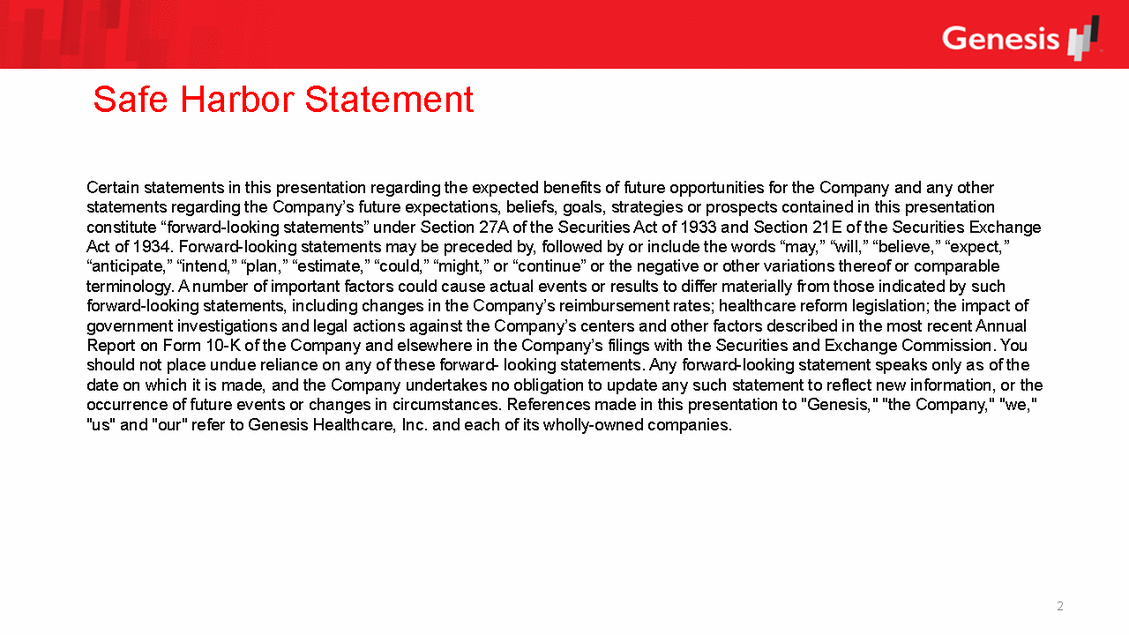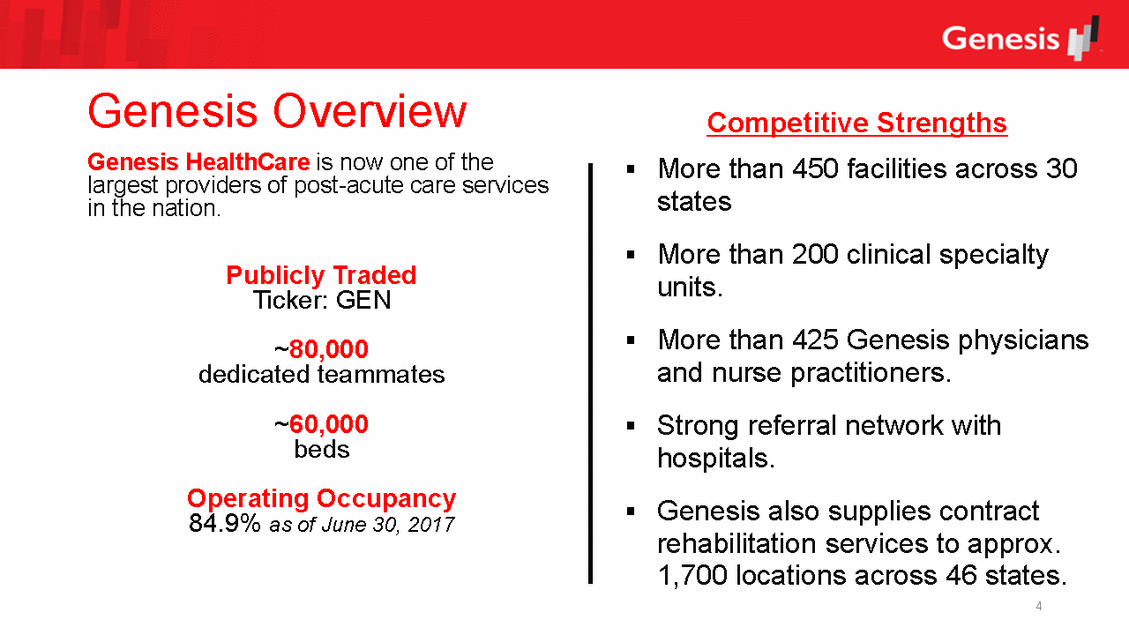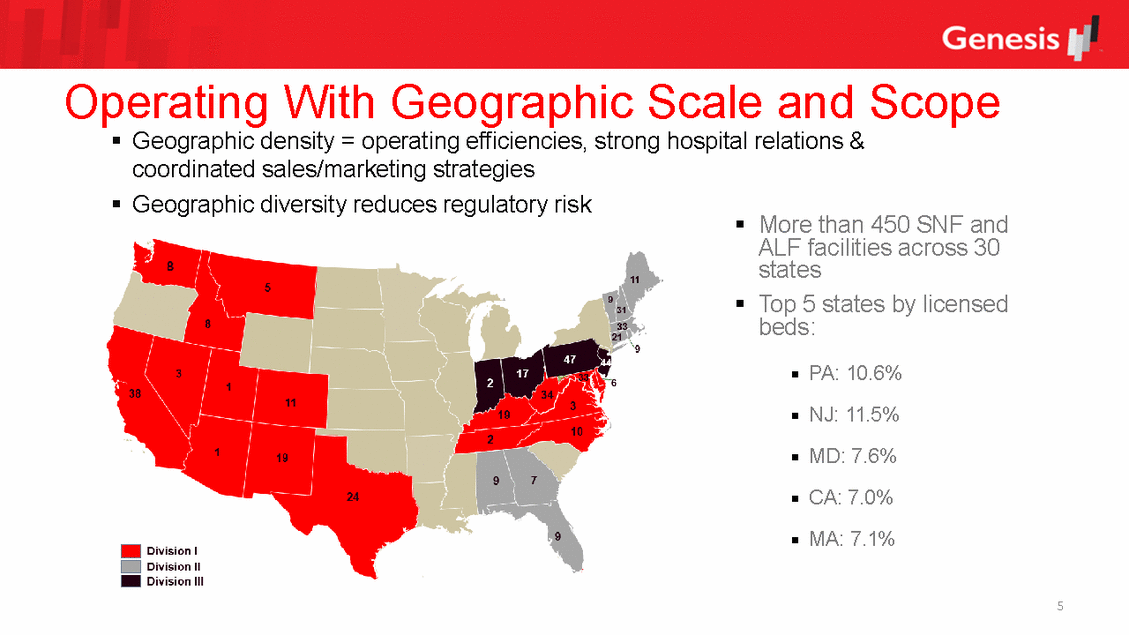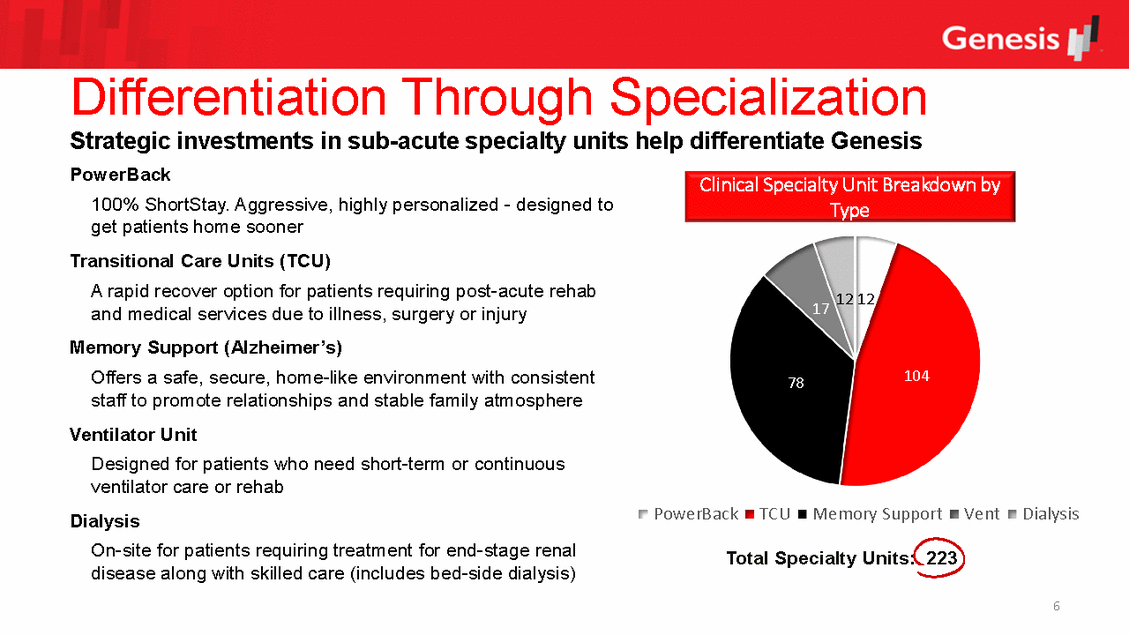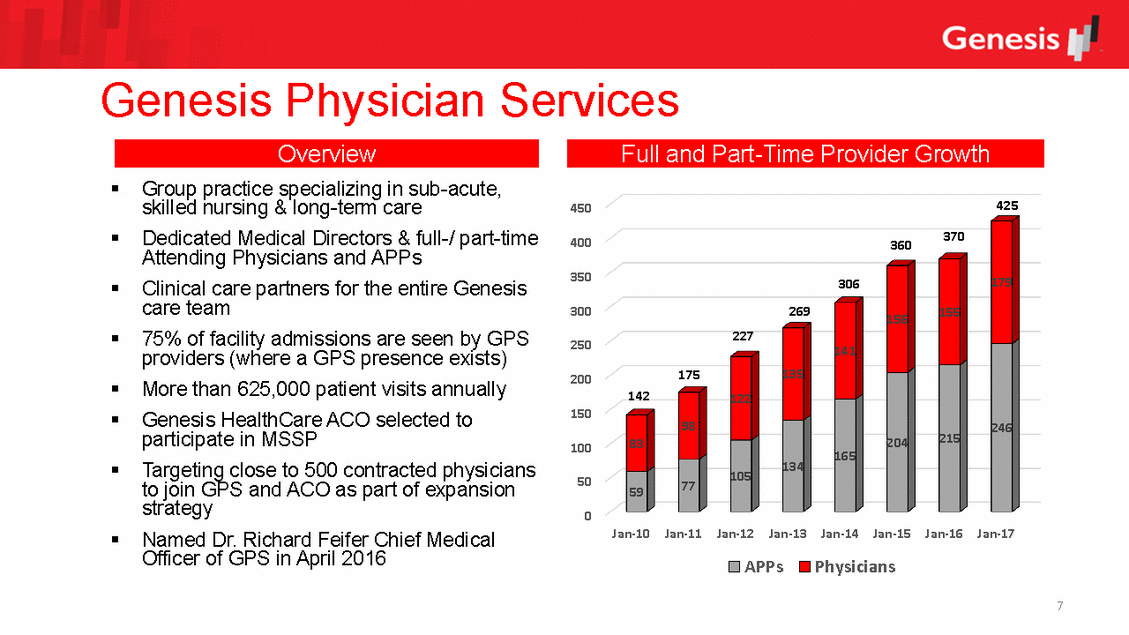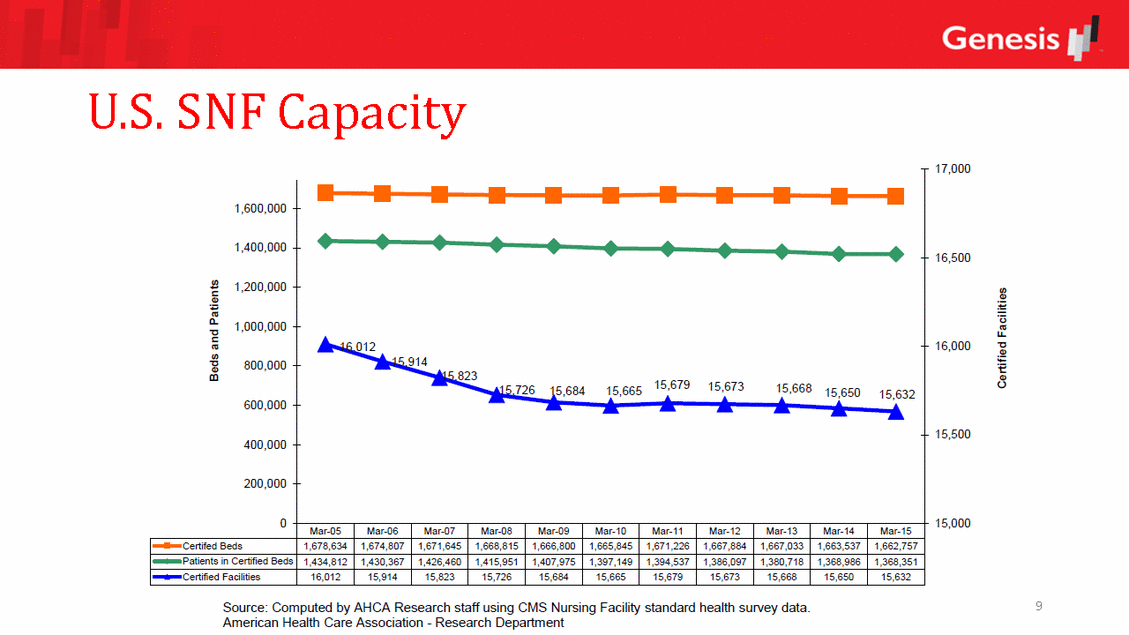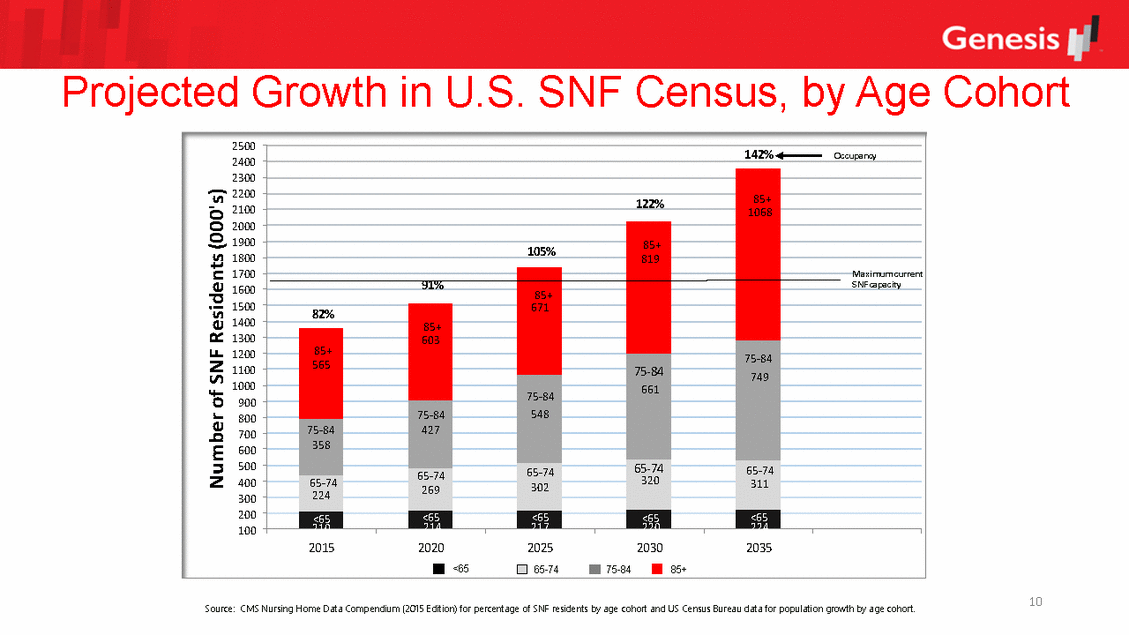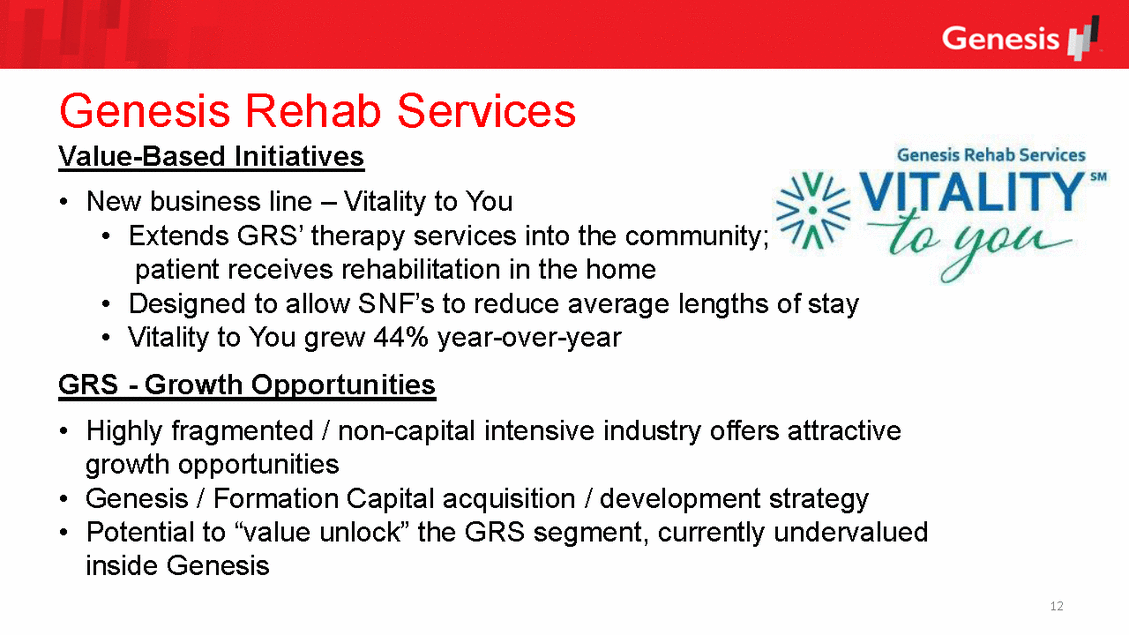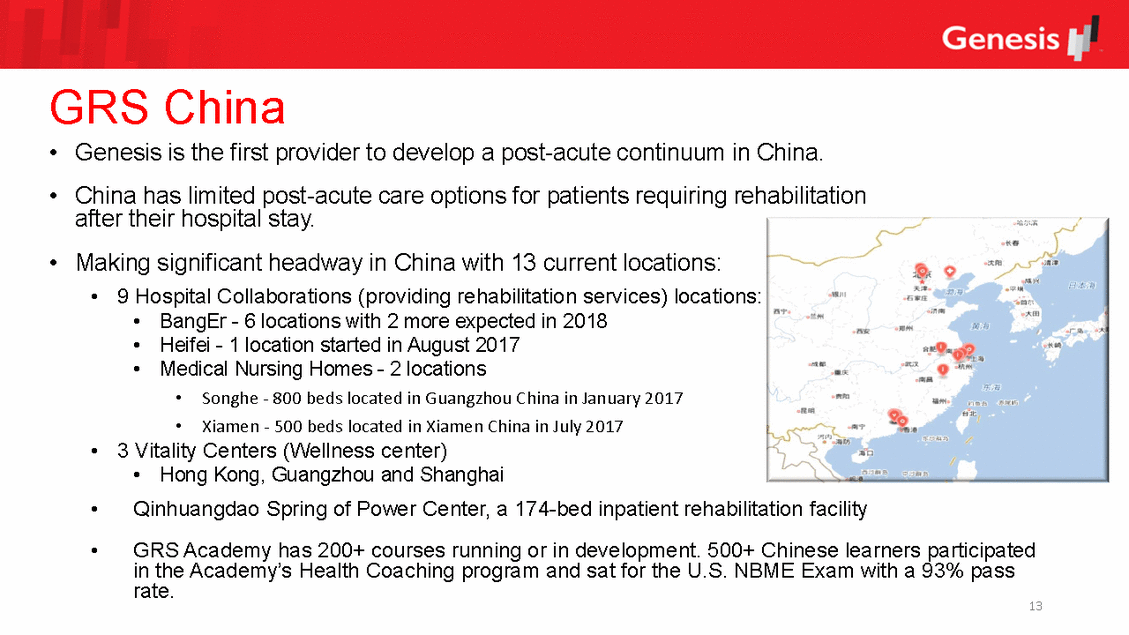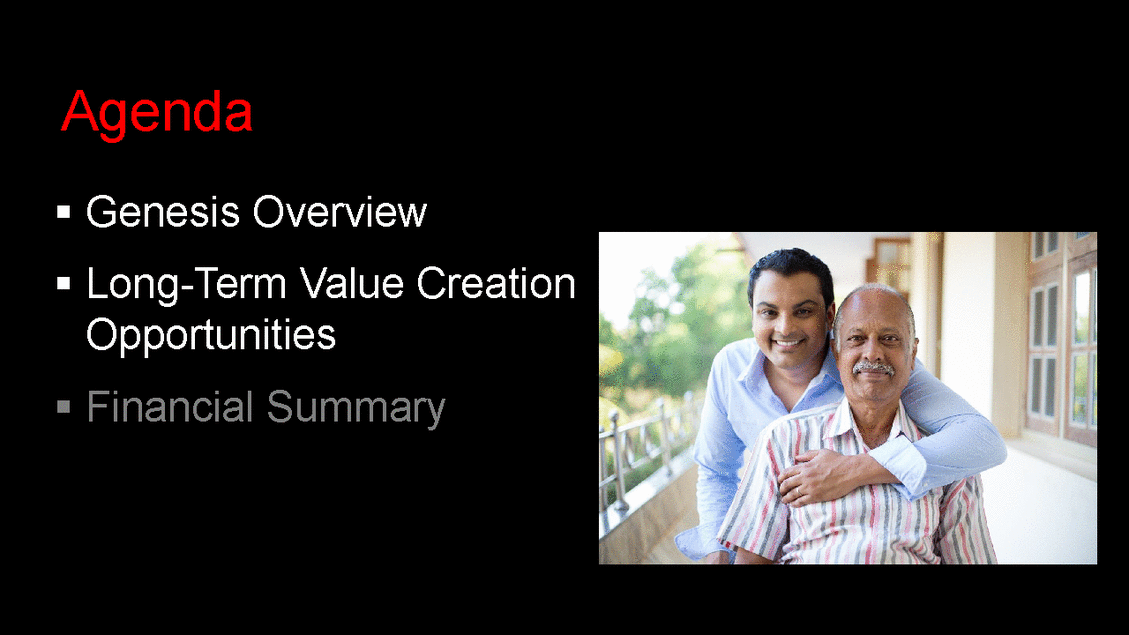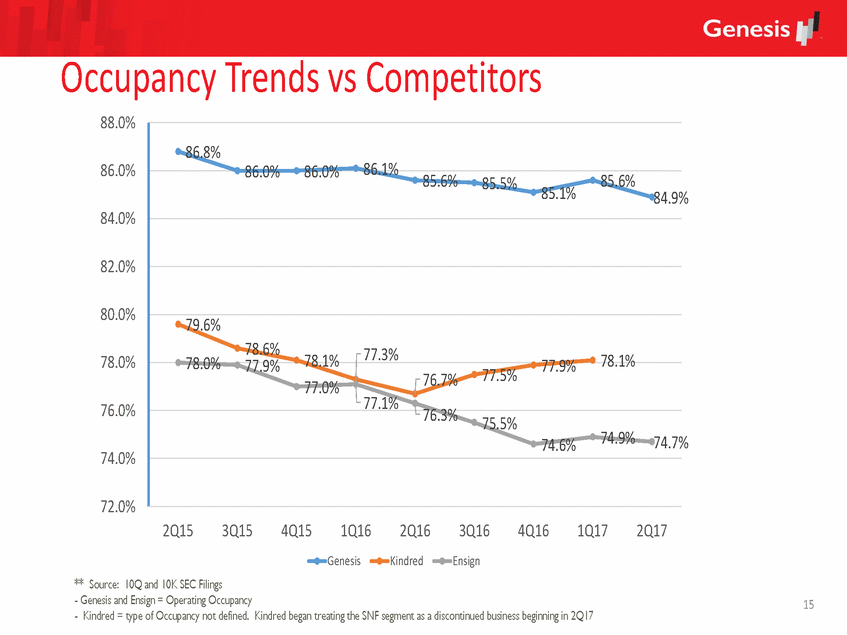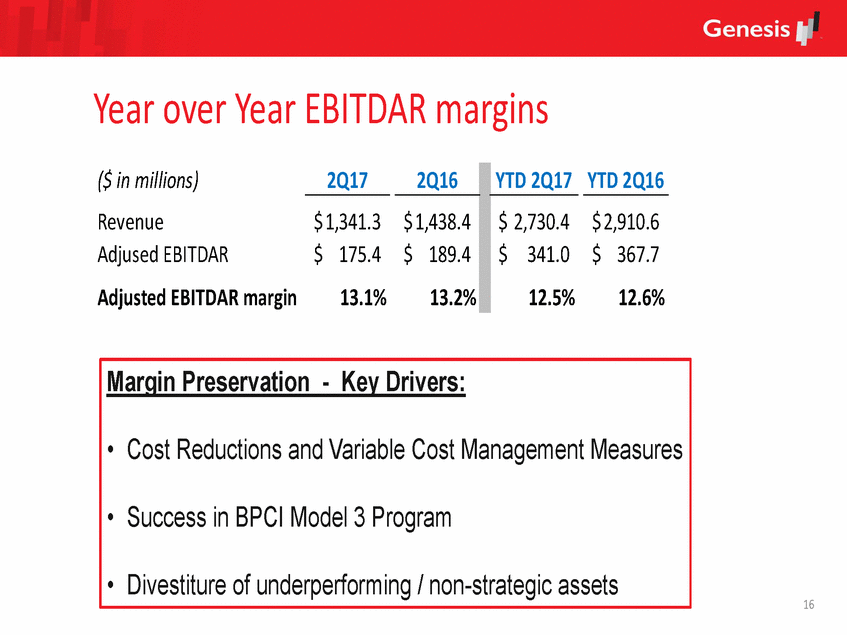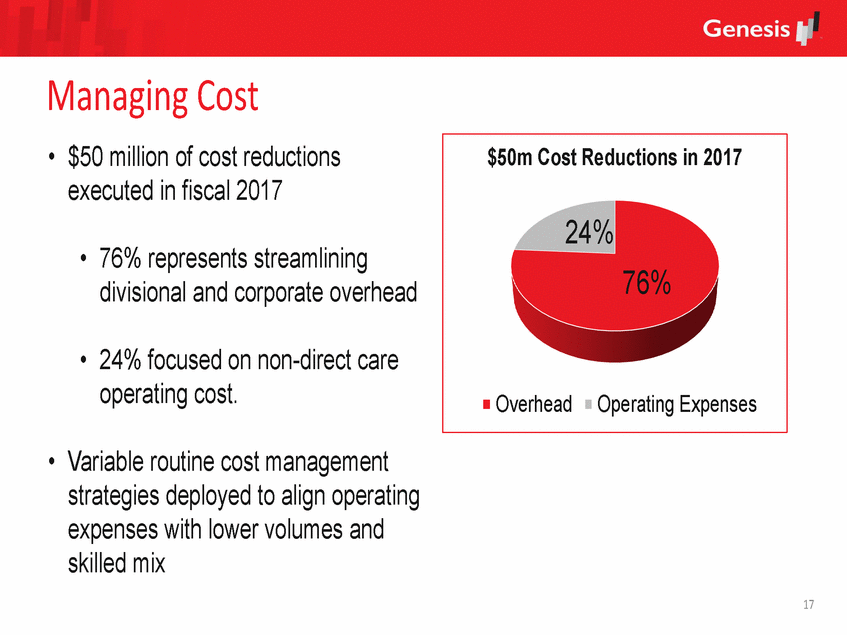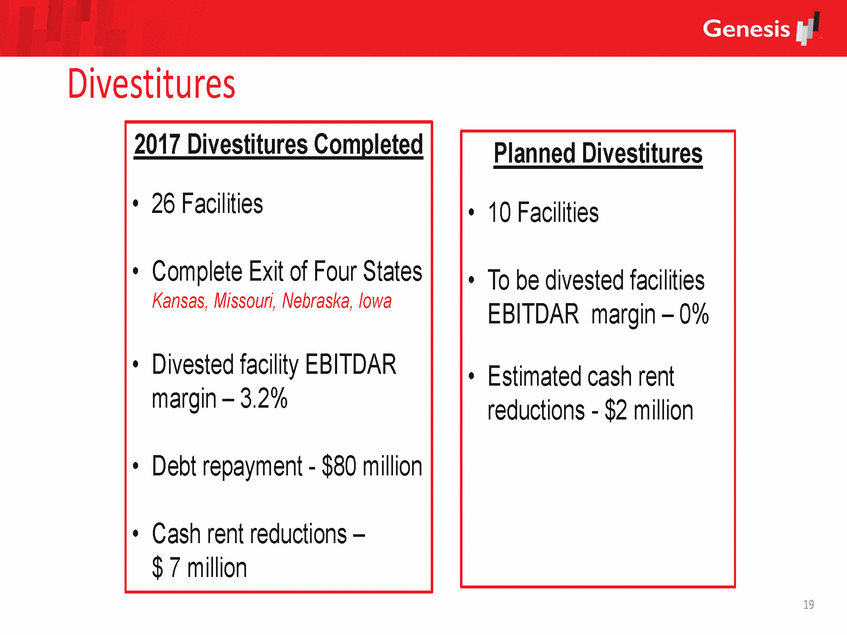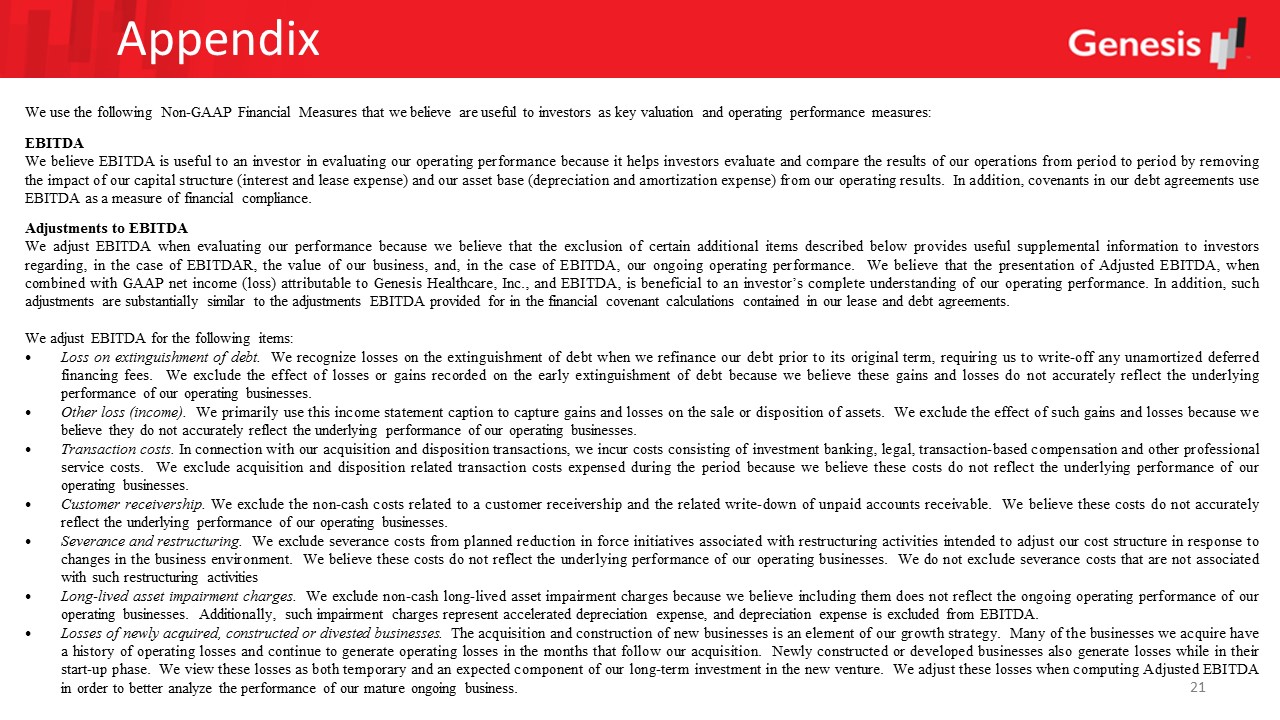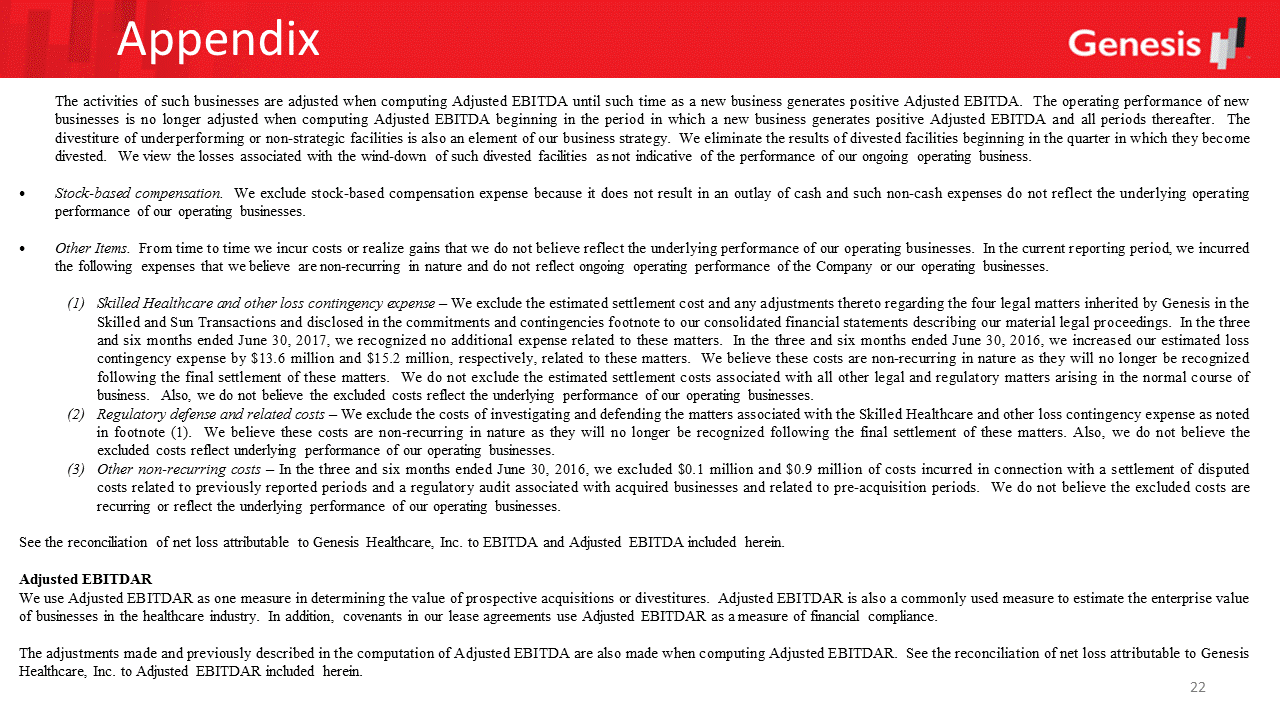Attached files
| file | filename |
|---|---|
| 8-K - 8-K - Genesis Healthcare, Inc. | gen-20170922x8k.htm |
|
|
A leading provider of post-acute services © 2017 by Genesis Healthcare, Inc. All Rights Reserved. September 2017 |
|
|
Safe Harbor Statement Certain statements in this presentation regarding the expected benefits of future opportunities for the Company and any other statements regarding the Company’s future expectations, beliefs, goals, strategies or prospects contained in this presentation constitute “forward-looking statements” under Section 27A of the Securities Act of 1933 and Section 21E of the Securities Exchange Act of 1934. Forward-looking statements may be preceded by, followed by or include the words “may,” “will,” “believe,” “expect,” “anticipate,” “intend,” “plan,” “estimate,” “could,” “might,” or “continue” or the negative or other variations thereof or comparable terminology. A number of important factors could cause actual events or results to differ materially from those indicated by such forward-looking statements, including changes in the Company’s reimbursement rates; healthcare reform legislation; the impact of government investigations and legal actions against the Company’s centers and other factors described in the most recent Annual Report on Form 10-K of the Company and elsewhere in the Company’s filings with the Securities and Exchange Commission. You should not place undue reliance on any of these forward-looking statements. Any forward-looking statement speaks only as of the date on which it is made, and the Company undertakes no obligation to update any such statement to reflect new information, or the occurrence of future events or changes in circumstances. References made in this presentation to "Genesis," "the Company," "we," "us" and "our" refer to Genesis Healthcare, Inc. and each of its wholly-owned companies. 2 |
|
|
Agenda GenesisOverview Long-TermValue Creation Opportunities Financial Summary |
|
|
Genesis Overview Competitive Strengths Genesis HealthCare is now one of the largest providers of post-acute care services in the nation. More than states More than units. More than and nurse 450 facilities across 30 200 clinical specialty Publicly Traded Ticker: GEN 425 Genesis physicians ~80,000 dedicated teammates ~60,000 beds practitioners. Strong referral network with hospitals. Genesis also supplies contract rehabilitation services to approx. 1,700 locations across 46 states. 4 Operating Occupancy 84.9% as of June 30, 2017 |
|
|
Operating WithGeographic Scaleand Scope coordinated sales/marketing strategies Geographic density = operating efficiencies, strong hospital relations & Geographic diversity reduces regulatory risk More than 450 SNF and ALF facilities across 30 states Top 5 states by beds: licensed PA: 10.6% NJ: 11.5% MD: 7.6% CA: 7.0% MA: 7.1% 5 |
|
|
Differentiation Through Specialization Strategic investments in sub-acute specialty units PowerBack 100% ShortStay. Aggressive, highly personalized - designed to get patients home sooner Transitional Care Units (TCU) A rapid recover option for patients requiring post-acute rehab and medical services due to illness, surgery or injury Memory Support (Alzheimer’s) Offers a safe, secure, home-like environment with consistent staff to promote relationships and stable family atmosphere Ventilator Unit Designed for patients who need short-term or continuous ventilator care or rehab Dialysis On-site for patients requiring treatment for end-stage renal disease along with skilled care (includes bed-side dialysis) help differentiate Genesis Clinical Specialty Unit Breakdown by Type 12 12 17 104 78 PowerBack TCU Memory Support Vent Dialysis Total Specialty Units: 223 6 |
|
|
Genesis PhysicianServices Overview Full and Part-Time Provider Growth Group practice specializing in sub-acute, skilled nursing & long-term care Dedicated Medical Directors & full-/ part-time Attending Physicians and APPs Clinical care partners for the entire Genesis care team 75% of facility admissions are seen by GPS providers (where a GPS presence exists) More than 625,000 patient visits annually Genesis HealthCare ACO selected to participate in MSSP Targeting close to 500 contracted physicians to join GPS and ACO as part of expansion strategy Named Dr. Richard Feifer Chief Medical Officer of GPS in April 2016 425 450 370 400 360 350 179 306 300 269 155 156 227 250 141 135 175 200 142 122 150 98 246 215 204 83 100 165 134 105 50 77 59 0 Jan-10 Jan-11 Jan-12 Jan-13 Jan-14 Jan-15 Jan-16 Jan-17 APPs Physicians 7 |
|
|
Agenda Genesis Overview Long-Term Value Creation Opportunities Financial Summary |
|
|
U.S. SNF Capacity 9 |
|
|
ProjectedGrowth in U.S. SNF Census, by Age Cohort 2400 2100 1800 1600 1400 1200 900 700 400 100 10 Source: CMS Nursing Home Data Compendium (2015 Edition) for percentage of SNF residents by age cohort and US Census Bureau data for population growth by age cohort. Number of SNF Residents (000's) 2500 2300 2200 2000 1900 1700 1500 1300 1100 1000 800 600 500 300 200 20152020202520302035 <6565-7475-8485+ 142%O ccupancy Maximum current SNF capacity 122% 85+ 1068 105% 85+ 819 91% 85+ 671 82% 85+ 603 85+ 565 75-84 749 75-84 661 75-84 548 75-84 427 75-84 358 65-74 311 65-74 320 65-74 302 65-74 269 65-74 224 <65 <65 <65 <65 <65 |
|
|
Changing Models of Genesis is well-positioned to Care Shaping theIndustry capitalize on value-based movement Bundled Payment for Care Improvement (“BPCI”) Medicare Shared Savings Program (“MSSP”) Existing Program Growth Opportunities Low Risk/Low Accountability to for High Risk/High Accountability Quality Members, Savings, Track Long-term trends towards cost efficiency and pay for quality may concentrate higher market share with fewer operators who demonstrate geographic scale and high quality outcomes, such as Genesis 11 Value-Based Care Models Shifting Payment Practices |
|
|
Genesis Rehab Services Value-Based Initiatives • New business line – Vitality to You • Extends GRS’ therapy services into the community; patient receives rehabilitation in the home Designed to allow SNF’s to reduce average lengths of stay Vitality to You grew 44% year-over-year • • GRS - Growth Opportunities • Highly fragmented / non-capital intensive industry offers attractive growth opportunities Genesis / Formation Capital acquisition / development strategy Potential to “value unlock” the GRS segment, currently undervalued inside Genesis • • 12 |
|
|
GRSChina • • Genesis is the first provider to develop a post-acute continuum in China. China has limited post-acute care options for patients requiring rehabilitation after their hospital stay. Making significant headway in China with 13 current locations: • • 9 Hospital Collaborations (providing rehabilitation services) locations: • • • BangEr - 6 locations with 2 more expected in 2018 Heifei - 1 location started in August 2017 Medical Nursing Homes - 2 locations • • Songhe - 800 beds located in Guangzhou China in January 2017 Xiamen - 500 beds located in Xiamen China in July 2017 • 3 Vitality Centers (Wellness center) • Hong Kong, Guangzhou and Shanghai • • Qinhuangdao Spring of Power Center, a 174-bed inpatient rehabilitation facility GRS Academy has 200+ courses running or in development. 500+ Chinese learners participated in the Academy’s Health Coaching program and sat for the U.S. NBME Exam with a 93% pass rate. 13 |
|
|
Agenda GenesisOverview Long-Term Value Creation Opportunities Financial Summary |
|
|
Occupancy Trends vs Competitors 88.0% 86.0% % 84.0% 82.0% 80.0% 78.6% 77.3% 78.1% 78.1% 78.0% 78.0% 77.0% 77.1% 76.0% 76.3% % 74.0% 72.0% 2Q15 3Q15 4Q15 1Q16 2Q16 Kindred 3Q16 Ensign 4Q16 1Q17 2Q17 Genesis ** Source: 10Q and 10K SEC Filings - Genesis and Ensign = Operating Occupancy - Kindred = type of Occupancy not defined. Kindred began treating the SNF segment as a discontinued business beginning in 2Q17 15 86.8% 86.0%86.0%86.1%85.6%85.5% 85.1%85.6%84.9 79.6% 77.9%76.7%77.5%77.9% 75.5% 74.6%74.9%74.7 |
|
|
Year over ($ in millions) Revenue Adjused EBITDAR Year EBITDAR margins 2Q17 YTD 2Q16 $ 1,341.3 $ 2,910.6 $ 175.4 13.1% $ 367.7 12.6% Adjusted EBITDAR margin 16 Margin Preservation - Key Drivers: •Cost Reductions and Variable Cost Management Measures •Success in BPCI Model 3 Program •Divestiture of underperforming / non-strategic assets 2Q16 YTD 2Q17 $ 1,438.4 $ 189.4 13.2% $ 2,730.4 $ 341.0 12.5% |
|
|
Managing Cost • $50 million of cost reductions executed in fiscal 2017 • 76% represents streamlining divisional and corporate overhead • 24% focused on non-direct care operating cost. • Variable routine cost management strategies deployed to align operating expenses with lower volumes and skilled mix 17 $50m Cost Reductions in 2017 24% 76% OverheadOperating Expenses |
|
|
Success in BPCI program $20.0 $15.0 $10.0 $5.0 $-2016 Actual 2017 Run Rate BPCI Gain Share (in $ mils) 18 •95% increase in estimated year-over-year gain share •Program returns have exceeded expectations •Invaluable experience gained operationalizing and managing the program •2Q17 v 2Q16 skilled admissions grew 0.5% in the 32 BPCI Participating SNFs as compared to a 3.3% decline in all other Genesis SNFs. $19.5 $10.0 |
|
|
Divestitures EBITDAR margin – 0% reductions - $2 million 19 Planned Divestitures •10 Facilities •To be divested facilities •Estimated cash rent 2017 Divestitures Completed •26 Facilities •Complete Exit of Four States Kansas, Missouri, Nebraska, Iowa •Divested facility EBITDAR margin – 3.2% •Debt repayment - $80 million •Cash rent reductions – $ 7 million |
|
|
Appendix |
|
|
Appendix We use the following Non-GAAP Financial Measures that we believe are useful to investors as key valuation and operating performance measures: EBITDA We believe EBITDA is useful to an investor in evaluating our operating performance because it helps investors evaluate and compare the results of our operations from period to period by removing the impact of our capital structure (interest and lease expense) and our asset base (depreciation and amortization expense) from our operating results. In addition, covenants in our debt agreements use EBITDA as a measure of financial compliance. Adjustments to EBITDA We adjust EBITDA when evaluating our performance because we believe that the exclusion of certain additional items described below provides useful supplemental information to investors regarding, in the case of EBITDAR, the value of our business, and, in the case of EBITDA, our ongoing operating performance. We believe that the presentation of Adjusted EBITDA, when combined with GAAP net income (loss) attributable to Genesis Healthcare, Inc., and EBITDA, is beneficial to an investor’s complete understanding of our operating performance. In addition, such adjustments are substantially similar to the adjustments EBITDA provided for in the financial covenant calculations contained in our lease and debt agreements. We adjust EBITDA for the following items: • Loss on extinguishment of debt. We recognize losses on the extinguishment of debt when we refinance our debt prior to its original term, requiring us to write-off any unamortized deferred financing fees. We exclude the effect of losses or gains recorded on the early extinguishment of debt because we believe these gains and losses do not accurately reflect the underlying performance of our operating businesses. Other loss (income). We primarily use this income statement caption to capture gains and losses on the sale or disposition of assets. We exclude the effect of such gains and losses because we believe they do not accurately reflect the underlying performance of our operating businesses. Transaction costs. In connection with our acquisition and disposition transactions, we incur costs consisting of investment banking, legal, transaction-based compensation and other professional service costs. We exclude acquisition and disposition related transaction costs expensed during the period because we believe these costs do not reflect the underlying performance of our operating businesses. Customer receivership. We exclude the non-cash costs related to a customer receivership and the related write-down of unpaid accounts receivable. We believe these costs do not accurately reflect the underlying performance of our operating businesses. Severance and restructuring. We exclude severance costs from planned reduction in force initiatives associated with restructuring activities intended to adjust our cost structure in response to changes in the business environment. We believe these costs do not reflect the underlying performance of our operating businesses. We do not exclude severance costs that are not associated with such restructuring activities Long-lived asset impairment charges. We exclude non-cash long-lived asset impairment charges because we believe including them does not reflect the ongoing operating performance of our operating businesses. Additionally, such impairment charges represent accelerated depreciation expense, and depreciation expense is excluded from EBITDA. Losses of newly acquired, constructed or divested businesses. The acquisition and construction of new businesses is an element of our growth strategy. Many of the businesses we acquire have a history of operating losses and continue to generate operating losses in the months that follow our acquisition. Newly constructed or developed businesses also generate losses while in their start-up phase. We view these losses as both temporary and an expected component of our long-term investment in the new venture. We adjust these losses when computing Adjuste2d1EBITDA in order to better analyze the performance of our mature ongoing business. |


